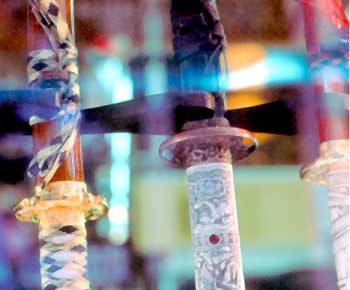


In this photograph of a window display of Japanese swords, the range of brightnesses, from bright to black, is satisfactory. In other words, no part of this particular photograph is too bright or too black -- you can see everything in this photographic print.

The human eye can see the white cat, the bright candle, and the chair in the dark room in the background. But there is a huge range between bright to black in the actual scene. The photograph can not show it all. The artist decided to expose for the candle flame -- to make it 'white' in the photograph. The other things are less than white. The white cat is now 'gray', the chair is too dark to show -- is black -- and the effect is perfect in the artist's mind.

This photograph of the same white cat in the sun, this time on a white ledge, is exposed so that the cat and ledge are both white. Notice how the room background is, thus, black. The artist, in this case, decides that the important thing is that the cat should be bright white. If you were standing in the same situation, your human eye would see a refrigerator in the shaded background. The cat is so bright, the photograph can not capture the darker background on the limited media.